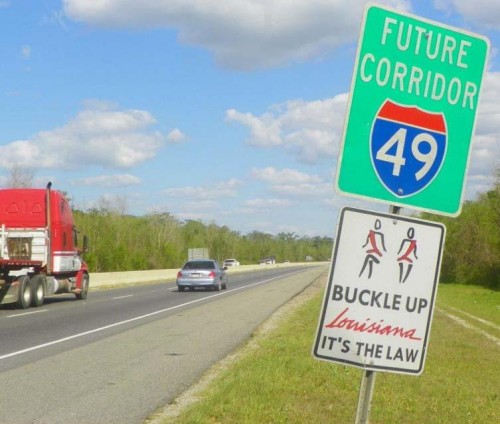
Is I-49 dead in south Louisiana?
March 29, 2011April 2: Ladybug Ball Children’s Festival (Houma)
March 31, 2011Tasked with alleviating the state’s $1.6 billion budget shortfall, Louisiana’s state legislature and the Jindal Administration are searching for new sources of revenue to balance the state’s hemorrhaging fiscal issues. On the potential chopping block are various tax exemptions and investment incentives provided by the state.
One investment incentive being discussed is the incentive to promote the exploration and development of oil and gas wells that involve horizontal drilling.
The state of Louisiana allows for the suspension of severance taxes due on production from horizontal and deep wells through eligibility of a 2-year severance tax exemption or until payout of qualified costs, whichever comes first. The Horizontal Well Severance Tax Investment Incentive is a key factor to the economic development of the Haynesville
Shale in northwest Louisiana.
Recently, Dr. Loren Scott, Professor Emeritus at Louisiana State University, conducted an extensive study that refutes arguments proposed by some who say the state is losing money by offering the horizontal tax incentive to the oil and gas industry. Contrary to these arguments, the incentive study proves that state revenues would actually decline if lawmakers repeal current oil and gas incentive programs.
Dr. Scott’s economic analysis determined that for every dollar the state of Louisiana gave up via the horizontal well severance tax investment incentive it gained $2.94 in revenues to the State Treasury. By utilizing the Department of Revenue’s Tax Exemption Budget data, it was estimated that in 2010, the state gave up $125.3 million, but it gained $367.7 million.
The study makes the case that the Haynesville Shale Play is one of many resource plays in the U.S. and Canada competing for exploration activity and capital investment dollars. Compared to other shale plays across the nation, the
Haynesville Shale is one of the most expensive to drill at $9 to $9.7 million per well, produces only dry gas, and has one of the lowest rates of return on investment (15.9 percent).
Dr. Scott notes, “The Haynesville is one of the most expensive to drill and has one of the lowest rates of return.
Therefore it is unreasonable to assume that, by removing the tax incentives, Louisiana stands to make millions of dollars from a captive industry.”
With record low natural gas prices, increased competition, and extremely expensive drilling costs, retaining the Horizontal Well Investment Incentive is key to ensuring that the Haynesville Shale development continues into our state’s future.
As the legislature convenes next month and addresses our looming economic woes, it’s crucial that lawmakers avoid policies that stand to harm industries that support job creation, investment dollars, and generate substantial revenue to the state. Repealing the Horizontal Well Severance Tax Incentive is a shortsighted policy approach that would actually exacerbate our state’s revenue shortfalls. From a long-term perspective, repealing the incentive would bring about a decline in Haynesville Shale growth, and most importantly, it would chase away significant future tax revenue from the state.
To view “The Economic Impact of the Horizontal Well Severance Tax Investment Incentive” study, visit www.loga.la/incentive.pdf.





